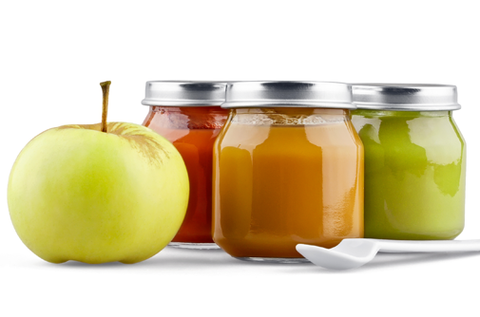
There are more and more children, and parents have less time. Given the global shortage of free minutes, both fathers and mothers have an acute question about feeding babies, which should be based on a balanced, healthy and tasty diet. When a child grows up, the need to provide a variety of dishes is added to this list.
Of course, many mothers at the birth of a baby put off all their affairs and begin to deal only with him, which is very correct. However, in this case, giving the child everything necessary in terms of nutrition is problematic. You will have to cook often, choosing environmentally friendly and safe products (for example, for mashed vegetables), which in today's reality is not easy to do.
That is why there is a need for complementary foods based on ready-made baby food, which is becoming more diverse every year and, in addition, is enriched with vitamins and minerals necessary for a growing body.
This state of affairs can be very attractive for organizing your own business. Baby food production today is an interesting and profitable niche with a competent approach and quality implementation.
What to produce: product type selection
Before you start preparing a business plan, you need to decide on the segment in which you plan to work. There are two of them in the baby food market:
- complementary foods are, in fact, all kinds of mashed potatoes and cereals;
- substitutes for mother’s milk, which are as close as possible to human milk and are suitable if it is not possible to breastfeed for some reason.
It is the complementary foods that occupy about 80% of the total market are in greatest demand. They are in demand by all groups of babies (and those who were fed naturally, and those who were fed with the help of a "bottle"). Therefore, the preferred choice is the production and sale of baby food for complementary foods. Despite a fairly large offer, there is room for new manufacturers in this segment. There will certainly be demand if consumers like the products.
Range of production: the choice of food groups
Children aged 3-4 months and up to about 3 years old are recommended to provide the most natural and healthy nutrition. That is, to feed them cereals, mashed potatoes, meat and fish dishes, brought to a special consistency. It is especially important to observe these rules if the child is under the age of one.
Then the more familiar food is gradually introduced into the diet, cooked in large enough slices and similar to what mom and dad eat. However, this does not mean that healthy nutrition for the baby should be boring and monotonous. This is where manufacturers come to the rescue, offering a wide selection of diverse and at the same time adapted products for the children's body.
What kind of complementary foods to produce? There may be several options:
- Dairy products, including dairy products (yoghurts, curds, etc.).
- Vegetable and fruit mixes. Among them are mixed juices, mashed potatoes, canned vegetables and cereals, etc. They can be of three types: finely and coarsely ground, homogenized. Suitable for babies from 3 months.
- Grain mixes. Not only cereals, but also instant cookies (yes, it happens), and even pasta. It can be given to children after 4-5 months.
- Meat and fish mixtures may also contain vegetable, vegetable components and dairy products. They differ in meat / fish content and degree of grinding. It is allowed to feed homogenized children from 5 months old, puree from 7 months, children over 9 months old - coarsely chopped.
Depending on the possibilities, mainly financial, it is possible to establish the production of baby food of all the above types. Or you can stop at canned vegetables and milk, and as the business develops, add the production of fish / meat mixtures to the proposed range of baby food.

Raw materials for production: what and why
The most important thing in feeding a child is to ensure that a sufficient amount of nutrients, minerals and vitamins is ingested into his body, as well as to prevent the ingress of low-quality or unsafe foods. This should be considered by manufacturers. The baby food business plan includes a careful selection of raw material suppliers.
Products for the preparation of mixtures should be grown in environmentally friendly conditions, without pesticides and antibiotics, and also be protected from possible infection by bacteria and fungi during transportation. This will have to be closely monitored both by the supplier (therefore, it must be verified and conscientious), and by the manufacturer itself, that is, you.
To organize the production of baby food of the above types, you will need the following types of raw materials:
- vegetables and fruits - apples, carrots, pumpkins, plums, apricots and peaches, cherries, currants and some others are especially popular;
- dairy products - whole, nonfat, dry, cream, sour cream;
- cereals - cereals and flour from them (oat, buckwheat, rice, wheat);
- meat and fish - poultry, beef, pork, cod, pike perch, hake, tuna, etc.
As for cost, prices fluctuate depending on seasonality and a number of other factors. On average, you can bring the following costs per kilogram of various types of raw materials (when buying in bulk):
- vegetables - up to 15 rubles;
- fruits and berries - up to 50-60 rubles;
- milk - 13-15 rubles per liter;
- grain - from 5 to 15-20 rubles;
- fish - from 75 to 200 rubles;
- meat and poultry - up to 300 rubles.
At the same time, the cost of a kilogram of baby food today is on average at least 500 rubles. That is, a business is capable of generating considerable profits even taking into account high prices for some types of fruits, as well as meat and fish products.
Baby food manufacturing technology
This section of the business plan is one of the most complex and capacious. Mainly because each specific type of product has its own characteristics of processing and preparation. The technology for the production of baby food varies depending on the type of product, the raw materials used and the necessary equipment for its processing. However, it is possible to highlight the general main stages that take place regardless of the type of manufactured products. These include:
- reception of raw materials from the supplier and its thorough inspection;
- purification and preparation of raw materials for the production process;
- dosage and mixing, heat treatment of products;
- packaging and packaging of finished products.
At each stage, it is important to comply with the established norms of baby food regarding the percentage of certain components, temperature conditions during heating, drying and storage and other requirements to ensure the proper quality of the finished product.
Let us consider in more detail the production of each individual type of baby food. The first in line are vegetable mixtures.
Preparation of vegetable mixtures
Preliminary preparations include fruit selection and purification. During it rotten, crushed vegetables and fruits are sifted out, unnecessary parts are removed (peel, seeds, etc.). Then the raw materials are washed and sent for grinding (to a certain state).Then the resulting mass is boiled with the addition of water and mixed according to the approved recipe. This is followed by the process of removing air from the product, heating and homogenization (if necessary). The final stage: the heated vegetable mixture is placed in a sterilized container and sealed.

Production of milk mixtures and fermented milk products
Raw materials after acceptance are sent for cooling to ensure better preservation. Before starting production, it is heated and separated. Pasteurization, normalization and homogenization processes follow. Then the raw materials are dried in a special drying apparatus in three stages. The finished product is mixed with additional components - casein, powdered sugar, etc., and packaged. Sources of iron and vitamins are added during the manufacturing process.
For fermented milk products, lactic acid, bifidobacteria and other useful ones are added to the raw materials. The fermentation time is different for each type of product: yogurt - up to 8 hours, kefir - 10-13 hours. After that, the products are fortified and filtered. Other components are added. At the same time, the proportion of sugar in the finished product should not exceed 5-7%.
Production of cereal mixtures
Before use, cereals are cleaned using a magnetic installation, sieved and ground. After that, at the mixing and dosing station, the components are mixed according to the recipe. The next step is to check for impurities and packaging.
Making canned meat and fish
Preliminary, the raw material is subjected to thorough processing - purification, removal of unnecessary elements (including skin, bones, etc.). Then it is cut, chopped, mixed with the addition of auxiliary components and wiped.
Additional raw materials for production are vegetable and butter, seasonings, vegetables. Next, the processed product is filtered, blanched. After homogenization and air removal, the resulting mass is packaged and sterilized for about an hour.
As you can see, the production of each type of baby food is associated with characteristic stages and processes that are different from the manufacture of others. Therefore, it is quite difficult and costly to establish efficient production of all product variants at the same time, because a variety of equipment is used. It is best to start with vegetable and milk mixtures. In the future, it is possible to expand the scope of activities by adding grain, meat and fish products to the assortment.
Implementation: distribution channels and advertising of baby food
In food production your activity does not end. Once the product is ready, it must be sold, in full and with the greatest benefit. How to do it? You should worry in advance about the methods of selling your product, choose marketing areas and ways to attract consumers to your brand.
Since production volumes, as a rule, exceed the needs of individual sellers, there should be several channels. This may be retail chains (supermarkets), individual grocery stores and specialized departments offering a variety of products for children. Some entrepreneurs, trying to keep up to date, open their own online stores with home delivery of baby food. Many parents like this idea, because with a small child time for shopping trips is often not enough.

How to promote?
As for advertising, you can carry out various promotions at points of sale of your products, give gifts to young mothers, hold contests with the opportunity to win a package of baby food, and more. It is also important to focus on packaging.
Bright, sunny, "talking" about the organic and fortified composition of the wrapper is an excellent advertisement for baby food that will appeal to both mothers and babies themselves.Additionally, you can order an advertising article in a specialized magazine for young parents. But the most important, of course, is the quality of products, a wide range and affordable price.
To summarize
The production of baby food is a difficult business, which requires a serious approach in the selection of raw materials, the establishment of the manufacturing process and constant quality control of products. A lot of effort will have to be spent on gaining customer confidence. However, in skilled hands, he is able to turn into a successful and profitable business, which brings joy to the entrepreneur himself and to consumers.








